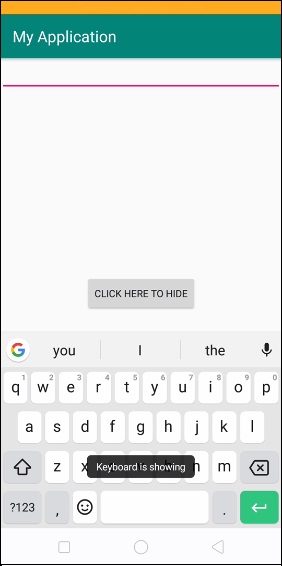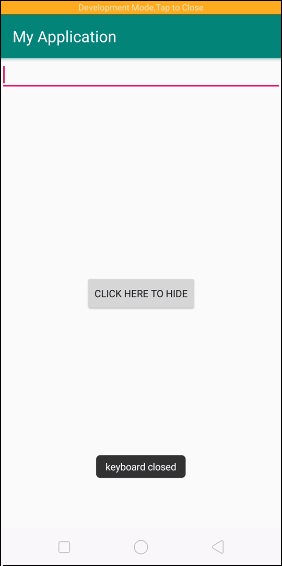
 Data Structure
Data Structure Networking
Networking RDBMS
RDBMS Operating System
Operating System Java
Java MS Excel
MS Excel iOS
iOS HTML
HTML CSS
CSS Android
Android Python
Python C Programming
C Programming C++
C++ C#
C# MongoDB
MongoDB MySQL
MySQL Javascript
Javascript PHP
PHP
- Selected Reading
- UPSC IAS Exams Notes
- Developer's Best Practices
- Questions and Answers
- Effective Resume Writing
- HR Interview Questions
- Computer Glossary
- Who is Who
How to check visibility of virtual keyboard on Android?
There are some situations, we should find keyboard is visible or not in particular activity. In this example we can check visibility of virtual keyboard on android.
Step 1 − Create a new project in Android Studio, go to File ⇒ New Project and fill all required details to create a new project.
Step 2 − Add the following code to res/layout/activity_main.xml.
<?xml version = "1.0" encoding = "utf-8"?> <android.support.constraint.ConstraintLayout xmlns:android = "http://schemas.android.com/apk/res/android" xmlns:app = "http://schemas.android.com/apk/res-auto" xmlns:tools = "http://schemas.android.com/tools" android:layout_width = "match_parent" android:layout_height = "match_parent" android:id = "@+id/rootview" tools:context = ".MainActivity"> <EditText android:id = "@+id/editext" android:layout_width = "match_parent" android:layout_height = "wrap_content"> </EditText> <Button android:id = "@+id/button" android:layout_width = "wrap_content" android:layout_height = "wrap_content" android:text = "Click here to hide" app:layout_constraintBottom_toBottomOf = "parent" app:layout_constraintLeft_toLeftOf = "parent" app:layout_constraintRight_toRightOf = "parent" app:layout_constraintTop_toTopOf = "parent" /> </android.support.constraint.ConstraintLayout>
Step 3 − Add the following code to src/MainActivity.java
import android.graphics.Rect;
import android.os.Build;
import android.os.Bundle;
import android.support.annotation.RequiresApi;
import android.support.constraint.ConstraintLayout;
import android.support.v7.app.AppCompatActivity;
import android.util.Log;
import android.view.View;
import android.view.ViewTreeObserver;
import android.view.inputmethod.InputMethodManager;
import android.widget.Button;
import android.widget.EditText;
import android.widget.Toast;
public class MainActivity extends AppCompatActivity implements View.OnClickListener {
ConstraintLayout constraintLayout;
@Override
protected void onCreate(Bundle savedInstanceState) {
super.onCreate(savedInstanceState);
setContentView(R.layout.activity_main);
Button button = findViewById(R.id.button);
EditText editText=findViewById(R.id.editext);
editText.requestFocus();
constraintLayout=findViewById(R.id.rootview);
constraintLayout.getViewTreeObserver().addOnGlobalLayoutListener(new ViewTreeObserver.OnGlobalLayoutListener() {
@Override
public void onGlobalLayout() {
Rect r = new Rect();
constraintLayout.getWindowVisibleDisplayFrame(r);
int screenHeight = constraintLayout.getRootView().getHeight();
int keypadHeight = screenHeight - r.bottom;
if (keypadHeight > screenHeight * 0.15) {
Toast.makeText(MainActivity.this,"Keyboard is showing",Toast.LENGTH_LONG).show();
} else {
Toast.makeText(MainActivity.this,"keyboard closed",Toast.LENGTH_LONG).show();
}
}
});
button.setOnClickListener(this);
}
@RequiresApi(api = Build.VERSION_CODES.O)
@Override
public void onClick(View v) {
switch (v.getId()) {
case R.id.button:
hideSoftkeybard(v);
break;
}
}
private void hideSoftkeybard(View v) {
InputMethodManager inputMethodManager = (InputMethodManager) getSystemService(INPUT_METHOD_SERVICE);
inputMethodManager.hideSoftInputFromWindow(v.getWindowToken(), 0);
}
}
In the above code we have used viewTreeObserver listener to find the view group changes in particular activity. In that observer we have find the root element height by using the following code −
int screenHeight = constraintLayout.getRootView().getHeight();
Now we have to find the keyboard height as shown below
Rect r = new Rect(); constraintLayout.getWindowVisibleDisplayFrame(r); int keypadHeight = screenHeight - r.bottom;
Now we have to compare keyboard height with rootview hight as shown below
if (keypadHeight > screenHeight * 0.15) {
Toast.makeText(MainActivity.this,"Keyboard is showing",Toast.LENGTH_LONG).show();
} else {
Toast.makeText(MainActivity.this,"keyboard closed",Toast.LENGTH_LONG).show();
}
Step 4 − Add the following code to AndroidManifest.xml file as shown below
<?xml version = "1.0" encoding = "utf-8"?> <manifest xmlns:android = "http://schemas.android.com/apk/res/android" package = "com.example.andy.myapplication"> <application android:allowBackup = "true" android:icon = "@mipmap/ic_launcher" android:label = "@string/app_name" android:roundIcon = "@mipmap/ic_launcher_round" android:supportsRtl = "true" android:theme = "@style/AppTheme"> <activity android:name = ".MainActivity" android:windowSoftInputMode = "stateAlwaysVisible"> <intent-filter> <action android:name = "android.intent.action.MAIN" /> <category android:name = "android.intent.category.LAUNCHER" /> </intent-filter> </activity> </application> </manifest>
In the above code we have added windowsoftInputMode as stateAlwaysVisible. It is useful when edittext is request focused it will show keyboard.
Let's try to run your application. I assume you have connected your actual Android Mobile device with your computer. To run the app from android studio, open one of your project's activity files and click Run ![]() icon from the toolbar. Select your mobile device as an option and then check your mobile device which will display your default screen
icon from the toolbar. Select your mobile device as an option and then check your mobile device which will display your default screen

In the above output, when keyboard is displayed, it will show message as keyboard is showing.

Click on a button to hide the keyboard. it will show the message as the keyboard closed as shown above.
Click here to download the project code

